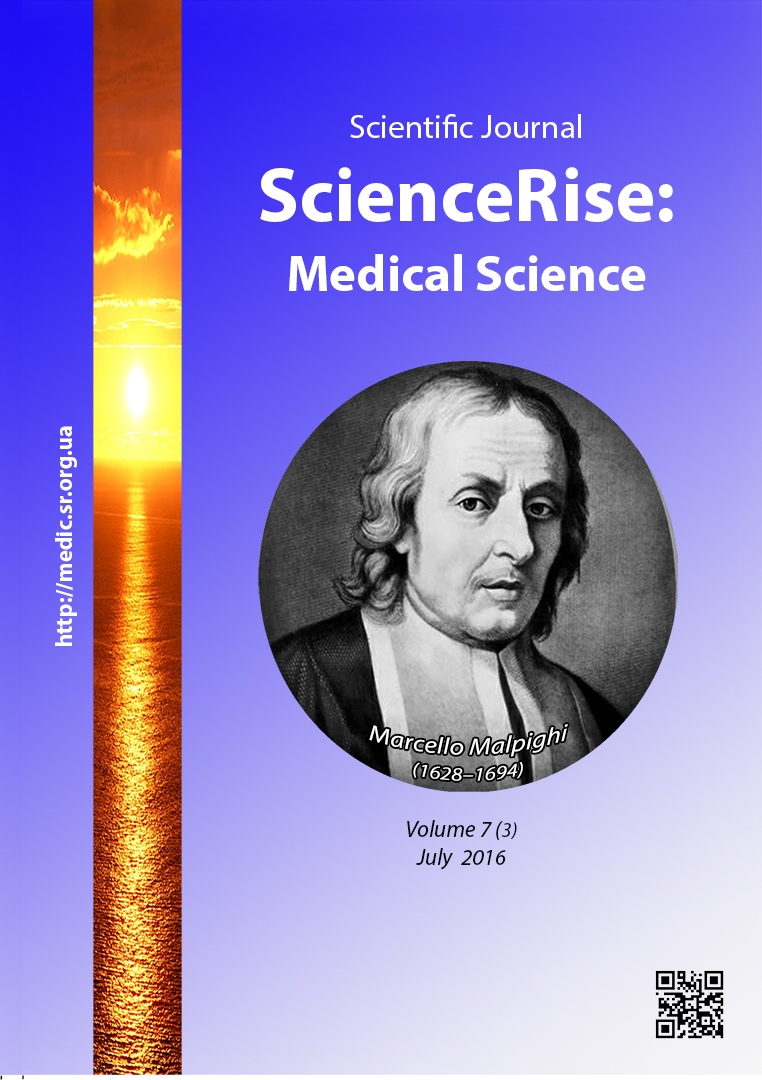Роль дисбалансу факторів агресії та захисту у шлунковому соку у розвитку кандидозу слизової оболонки верхнього відділу травного тракту
DOI:
https://doi.org/10.15587/2519-4798.2016.74449Ключові слова:
кандидоз, слизова оболонка, глікопротеїн, фукоза, гексозаміни, вузловий зоб, щитоподібна залозаАнотація
Результати досліджень демонструють здатність Candida albicans стимулювати синтез глікопротеїнів при інвазії у слизову оболонку на тлі структурної деградації муцину з підвищенням індексів співвідношень основних компонентів слизового гелю за рахунок зниження фукози. Асоціація індексів деградації та гіперплазії щитоподібної залози і вузлового зобу зумовлює необхідність визначення можливої єдності патогенетичних процесів їх розвитку
Посилання
- Hoffman, M. P., Haidaris, C. G. (1993). Analysis of Candida albicans Adhesion to Salivary Mucin. Infection and Immunity, 61 (5), 1940–1949.
- Ellepola, A. N. B., Samaranayake, L. P. (2000). Oral Candidal Infections and Antimycotics. Critical Reviews in Oral Biology & Medicine, 11 (2), 172–198. doi: 10.1177/10454411000110020301
- Yakoob, J. (2003). Candida esophagitis: Risk factors in non-HIV population in Pakistan. World Journal of Gastroenterology, 9 (10), 2328. doi: 10.3748/wjg.v9.i10.2328
- Patil, S., Rao, R. S., Majumdar, B., Anil, S. (2015). Clinical Appearance of Oral Candida Infection and Therapeutic Strategies. Frontiers in Microbiology, 6. doi: 10.3389/fmicb.2015.01391
- Kushnirenko, I. V. (2016). Ozenka sostoyania komorbidnosti u pazientov s kandidozom slizistoy obolochky verchnego ordela zheludochno-kishechnogo trakta [Evaluation of comorbidity in patients with candidiasis of mucosa of the upper gastrointestinal tract]. Medicine (Almaty), 5 (167), 73–77.
- Bansil, R., Turner, B. S. (2006). Mucin structure, aggregation, physiological functions and biomedical applications. Current Opinion in Colloid & Interface Science, 11 (2-3), 164–170. doi: 10.1016/j.cocis.2005.11.001
- Kim, Y. S., Ho, S. B. (2010). Intestinal Goblet Cells and Mucins in Health and Disease: Recent Insights and Progress. Current Gastroenterology Reports, 12 (5), 319–330. doi: 10.1007/s11894-010-0131-2
- Linden, S. K., Sutton, P., Karlsson, N. G., Korolik, V., McGuckin, M. A. (2008). Mucins in the mucosal barrier to infection. Mucosal Immunology, 1 (3), 183–197. doi: 10.1038/mi.2008.5
- De Repentigny, L., Aumont, F., Bernard, K., Belhumeur, P. (2000). Characterization of Binding of Candida albicans to Small Intestinal Mucin and Its Role in Adherence to Mucosal Epithelial Cells. Infection and Immunity, 68 (6), 3172–3179. doi: 10.1128/iai.68.6.3172-3179.2000
- Sheleketina, I. I., Kozhuhar', N. P., Minko, A. F. (1981). K metodike opredelenija aktivnosti pepsina v zheludochnom soke. Laboratornoe delo, 4, 254–255.
- Sheleketina, I. I., Kozhuhar, N. P., Minko, A. Ph., Rudenko, A. I. (1983). Kolechestvennyj metod opredeleniya gastromekoproteidov. Кyiv, 63, 3.
- Pokcrovskaya, M. I. (Ed.) (1982). Metody biochimicheskih issledovaniy. Leningrad: Leningradskij un-tet, 272.
- Becker, D. J., Lowe, J. B. (2003). Fucose: biosynthesis and biological function in mammals. Glycobiology, 13 (7), 41R–53R. doi: 10.1093/glycob/cwg054
- Pickard, J. M., Chervonsky, A. V. (2015). Intestinal Fucose as a Mediator of Host-Microbe Symbiosis. The Journal of Immunology, 194 (12), 5588–5593. doi: 10.4049/jimmunol.1500395
- Goto, Y., Obata, T., Kunisawa, J., Sato, S., Ivanov, I. I., Lamichhane, A. et. al. (2014). Innate lymphoid cells regulate intestinal epithelial cell glycosylation. Science, 345 (6202), 1254009–1254009. doi: 10.1126/science.1254009
- Hurd, E. A. (2005). Gastrointestinal mucins of Fut2-null mice lack terminal fucosylation without affecting colonization by Candida albicans. Glycobiology, 15 (10), 1002–1007. doi: 10.1093/glycob/cwi089
- Hurd, E. A., Domino, S. E. (2004). Increased Susceptibility of Secretor Factor Gene Fut2-Null Mice to Experimental Vaginal Candidiasis. Infection and Immunity, 72 (7), 4279–4281. doi: 10.1128/iai.72.7.4279-4281.2004
- Motta, P. M. (Ed.) (1984). Electron microscopy in biology and medicine. Current Topics in Ultrastructural Research. Martinus nijhoff publishers, Boston, 349.
##submission.downloads##
Опубліковано
Як цитувати
Номер
Розділ
Ліцензія
Авторське право (c) 2016 Інесса Василівна Кушніренко

Ця робота ліцензується відповідно до Creative Commons Attribution 4.0 International License.
Наше видання використовує положення про авторські права Creative Commons CC BY для журналів відкритого доступу.
Автори, які публікуються у цьому журналі, погоджуються з наступними умовами:
1. Автори залишають за собою право на авторство своєї роботи та передають журналу право першої публікації цієї роботи на умовах ліцензії Creative Commons CC BY, котра дозволяє іншим особам вільно розповсюджувати опубліковану роботу з обов'язковим посиланням на авторів оригінальної роботи та першу публікацію роботи у цьому журналі.
2. Автори мають право укладати самостійні додаткові угоди щодо неексклюзивного розповсюдження роботи у тому вигляді, в якому вона була опублікована цим журналом (наприклад, розміщувати роботу в електронному сховищі установи або публікувати у складі монографії), за умови збереження посилання на першу публікацію роботи у цьому журналі.










